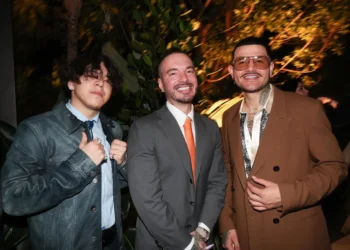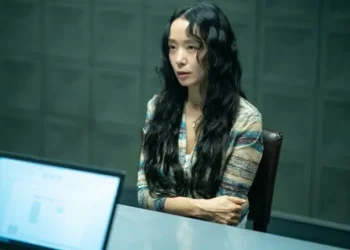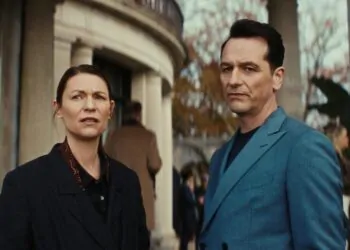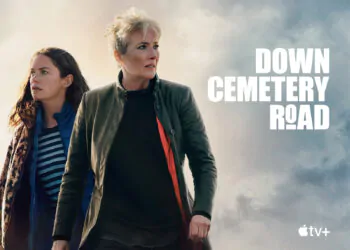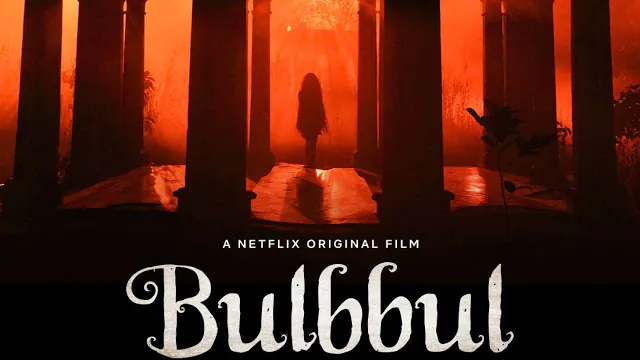Romantic comedies have consistently thrived on portraying the fantasy of transformative love stories that alter the lives of their main characters. Iain Morris’ My Oxford Year, based on Julia Whelan’s novel of the same name, streaming now on Netflix, certainly aims to capture the essence of such life-changing romance, all set against the picturesque backdrop of Oxford University. With a screenplay penned by Allison Burnett and Melissa Osborne, the film heavily relies on traditional genre tropes, featuring an ambitious American newcomer, a charming yet complex British love interest, and a richly traditional setting. The end result is a film that presents a polished exterior and finds occasional moments of warmth, yet ultimately falls short in delivering the necessary depth and emotional impact to truly stand out.
Story
The story follows Anna De La Vega (Sofia Carson), a driven American student who has dedicated herself to earning a place at Oxford. Bright, self-assured, and fiercely independent, Anna arrives in England eager to tackle her academic challenges while navigating a promising career back in the United States. Almost immediately, she has a chance encounter—both literally and metaphorically—with Jamie Davenport (Corey Mylchreest), a witty local whose playful arrogance conceals deeper issues.
Performances
Much of the film rests on Sofia Carson’s performance, and to her credit, she is a captivating presence. Carson infuses Anna with a vibrant determination, showcasing the balance of ambition and vulnerability that characterizes her role. Her chemistry with Corey Mylchreest, though adequate, does not reach electrifying levels.
However, Carson’s portrayal is somewhat limited by the screenplay, which fails to provide Anna with sufficient interiority beyond her typical drive and eventual romantic awakening. Her challenges often seem superficial, and even as Carson attempts to add nuance, the script restricts her to a glossy, idealized portrayal.
Mylchreest performs somewhat better, bringing both charm and a touch of gravitas to Jamie. His portrayal carries a sense of authenticity, particularly in later scenes where he grapples with family issues. The supporting cast, including Scott and McCormack, lend credibility to their roles, though they primarily serve functional purposes without much depth. Trevaldwyn, on the other hand, achieves some of the film’s best comedic moments, even as his character risks becoming a cliché “quirky best friend.”
Behind the scenes
On a positive note, My Oxford Year is never outright unpleasant. Its light-hearted tone makes for an enjoyable watch, making it appealing to fans of Sofia Carson or those in search of a comforting, escapist romantic tale. The humor, while mild, prevents the film from becoming excessively serious, and its runtime is effortlessly digestible.
The film also benefits from its location; Oxford transcends a mere backdrop to become a character in its own right. Its centuries-old traditions, academic practices, and captivating sites contribute to the film’s unique sense of place. Although the narrative does not fully exploit the dramatic possibilities of its setting, its visual allure is undeniable.
Director Iain Morris, known for co-creating The Inbetweeners, adopts a surprisingly subdued approach in this film. Abandoning the raunchy comedic tones of his earlier works, Morris opts for a straightforward romance adorned with polished cinematography and stunning visuals of Oxford. While the film is visually appealing—featuring beautiful spires, libraries, and cobblestone streets—the aesthetic charm often lacks the emotional substance needed to leave a lasting impression.
Scenes frequently unfold in a predictable manner, lacking tension or unpredictability. The direction seldom delves into the nuanced complexities of ambition, sacrifice, or cultural clashes. For a story centered around life-altering choices, the film’s risk-averse nature feels bewildering.
Final Verdict
Despite the premise having the potential for a classic romantic narrative, the film often feels as if it is merely ticking off boxes rather than crafting genuine emotional moments. Anna’s professional aspirations, Jamie’s family dilemmas, and the cultural differences between America and England are all present, yet they rarely receive the depth they warrant.
The film’s main flaw lies in its predictability. From the moment Anna and Jamie meet, the course of their relationship seems predetermined. The screenplay hints at deeper conflicts—such as career versus love, and personal ambition versus familial obligations—but ultimately resolves these tensions in a tidy rather than authentic manner.
Furthermore, the film lacks clarity in whether it aims to be a lighthearted romantic comedy or a sincere romantic drama. When it tilts towards humor, the laughs are modest; when it ventures into dramatic territory, the stakes feel underwhelming. Consequently, the movie exists in a middle zone—pleasant yet seldom impactful.
Ultimately, My Oxford Year is a film that aspires to timelessness but settles for being pleasant. With its attractive cast, charming setting, and easily digestible plot, it is likely to attract viewers seeking a soft romantic getaway. However, for those hoping for something deeper, more emotionally resonant, or sharply comedic, the film disappointingly falls short.
It stands as a quintessential example of an average romance: polished, visually appealing, and buoyed by Sofia Carson’s charisma, yet too predictable and shallow to make a lasting impression. Like an Oxford postcard tucked away in a drawer, it is lovely to look at but does not invite revisiting.



